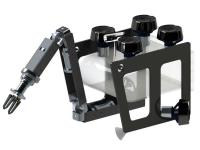Hitting Rock Bottom for Success – the Student Underwater Robotics Association
They established a student research association to participate in an underwater robotics competition. They say we should wish they hit rock bottom, because paradoxically, this will spell success. Students of the Faculty of Power and Aeronautical Engineering are constructing an underwater robot.
Tomasz Bartkowiak, Marek Głuchowski and Andrzej Daniluk established the Student Underwater Robotics Association in December 2015. Today, their seven-strong team boasts of three mechanics, two electronics engineers, one IT specialist and one marketing and promotion person. Paweł Malczyk Ph.D. D.Sc. of the Department of Machine and Robot Theory supervises the Association.
Setting out to Conquer the World
The MATE 2016 competition prompted the establishment of the student research association. The Underwater Robotics competition organised by the Marine Advanced Technology Education Center is the most prestigious underwater robotics event in the world. This year, it is held in the NASA Neutral Buoyancy Lab at the Johnson Space Center in Houston, Texas, USA, which is an additional lure for the students to take part.
The MATE competition requires students to think of themselves as entrepreneurs. In addition to engineering their ROVs, students are required to prepare technical reports, poster displays and engineering presentations that are delivered to competition judges. According to the members of Student Underwater Robotics Association, this is the best way to start a company in the future.
A Robot Like no Other
The machine, which the Student Underwater Robotics Association is working on, is a ROV; an unmanned, remotely operated, underwater vehicle, which communicates with an earth station and is operated from above the surface with the help of joysticks. The robot is equipped with a camera, thanks to which its operator can see what is happening under water.
In accordance with the competition requirements, the robot developed by the Student Underwater Robotics Association is designed to work at a depth of 12 metres. “The deeper the machine has to go down, the better sealing and the heavier structure of the machine are needed”, says Marek Głuchowski, Deputy President of the Association and a student of Mechanics and Machine Design at the Faculty of Power and Aeronautical Engineering.
However, the conditions at a depth of 10-12 metres do not require the metal structure of the whole robot. That is why, to a large extent, the machine is built of plastic elements made using the 3D printing method. “What makes our design unique is that we used materials of better quality”, Tomasz Bartkowiak, President of the Association and a student of Aviation and Aerospace Engineering, explains. “The robot’s body is made of acrylic, the frames are made of polycarbonate and the reinforcement elements are made of ABS (thermoplastic polymer)”.
The robot is equipped with two cameras and a manipulator arm with a grip. The grip is an indispensable element, as during the competition the ROV will have to rotate various elements under water. All the competition tasks are inspired by real life missions for such machines. During the competition, the robot designed by the students from the Warsaw University of Technology will measure the pressure and temperature under water, calculate ice thickness using pressure methods and take oil samples. The robot must also recognise shapes.
Taking the Plunge
The structure designed by the WUT students is almost ready. In order to avoid risking a short-circuit, its individual elements are checked one at a time. The robot’s body housing all the electronics has already passed initial tests.
The designers are looking for a location where they can test the whole robot underwater, at a depth of 10 meters. “It must take a plunge and we must check that it goes down”, Marek Głuchowski says jokingly.
“Strangely enough, it is good news if it does”, Tomasz Bartkowiak comments.
The American Dream
The MATE 2016 competition will be held on 23-25 June 2016. In order to qualify for the competition, student association members need to record a video presenting the robot performing one of the competition tasks. To complete the design, the Student Underwater Robotics Association needs to raise PLN 10,000. The cost of participation of the seven-strong team in the competition reaches PLN 50,000.
The students of the Warsaw University of Technology believe that the trip to the USA is within their reach. However, they emphasise that their project is not only about the competition. “Each one of us wants to do more than just studying. Student research associations are the best testing grounds for us”, Marek Głuchowski says. “They will help us to navigate the labour market in the future”.
Author: Monika Bukowska, Office for Promotion and Information
Student Underwater Robotics Association: sknrp@meil.pw.edu.pl








